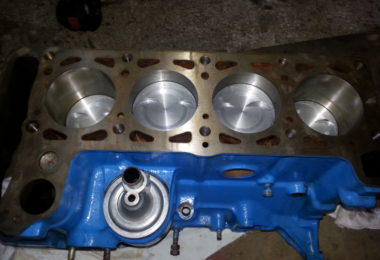Grand Touring Concepts is excited to share the experience and knowledge of fellow Lada enthusiast Nagy Emil! Please read on as he covers the principles of Lada Engine compression ratios and answers some common questions about the topic.
How to, and Why Raise the Compression Ratio the Lada Family of Engines Part 1
By Nagy Emil
What is Compression Ratio, and what is it in my Lada?
The compression ratio (CR) of an engine is often noted with the greek letter ε, and is a volumetric ratio between the volume of the combustion chamber when the piston reaches the top dead center, (TDC) and when it reaches bottom dead center (BDC). In a petrol engine, CR value is limited by the octane rating of the fuel, and the technical necessity to avoid detonation. Detonation is unwanted self-ignition of the fuel, that can cause severe damage to the engine internals, and could lead to critical engine failure. CR is parameter present in the formula of engine mechanical efficiency, so the higher it is, the better the engine efficiency and performance.
In the case of the Lada engine, the CR was restricted to the value of 8.5:1, which is considered quite low for a petrol engine. This due to the poor quality of the fuel that could be easily found in the Soviet Union (85 octane fuel, that in reality was never close to this value), and early distributors were equipped with a manual “octane” corrector, a mechanism from which you could regularly adjust spark advance depending on what quality fuel was used.

image source: http://www.veteranzsiguli.hu/files/9_Gyujtastorony_csavaros.JPG
On the early Lada 2101 engine, cylinder heads were developed with a smaller combustion chamber, thus the CR was higher than 8.5:1, but shortly after they dropped the design and used the later developed 2011 code cylinder heads. These have a combustion chamber close to 41.3 cc. Lada engineers adopted the following progressive solutions to prevent the increase of the CR:
2101-1 type engine, was equipped with “flat top” pistons, and used the 2101-1 type cylinder head;
2103 type engine, used “flat top” pistons, a 2101-1 type cylinder head, but the pistons are 1.8mm below deck at TDC.
2106 type engine, pistons have a recess (dish), 2101-1 type cylinder head, and share the same 1.8 mm below deck setup like the 2103 type engine.
Nowadays, higher octane rated petrol is used and very common, 95 octane is somewhat standard (especially in Europe), so standard petrol engines have even a 10.5:1 CR and not experience detonation. Therefore, modifying the engine to achieve a higher CR could come useful in the following circumstances:
When installing a more aggressive camshaft (higher lift, higher valve overlap); it is a must, because of the higher lift and valve overlap, the cylinder pressure drops at low rpms which harms engine output. Increasing the compression ratio will recover this lost cylinder pressure and add power.;
Increasing the efficiency of the engine – especially higher torque production.
In Part 2, Emil will take you through the common ways of increasing the Compression Ratio, and some considerations that are specific to the Lada Engine.
